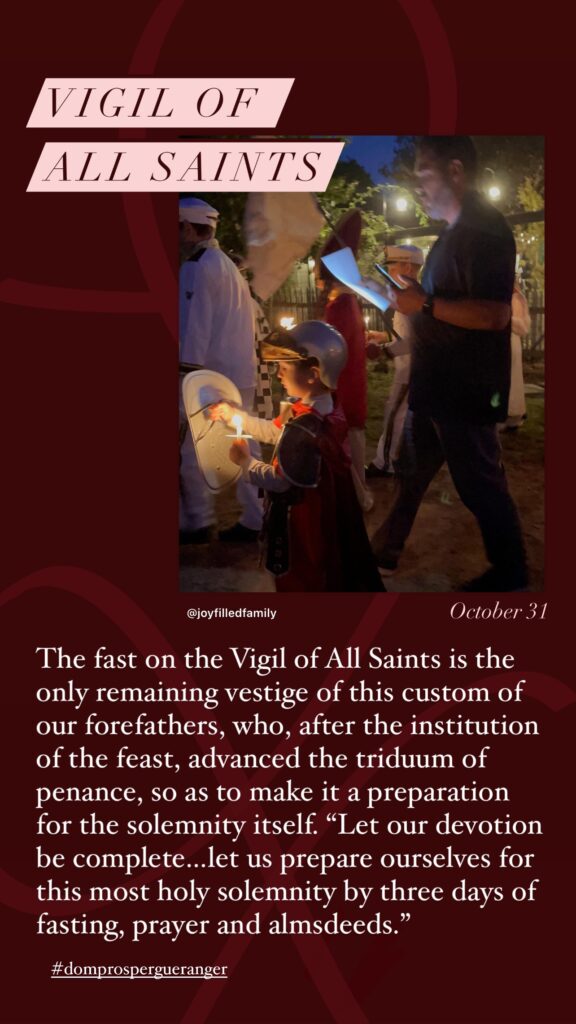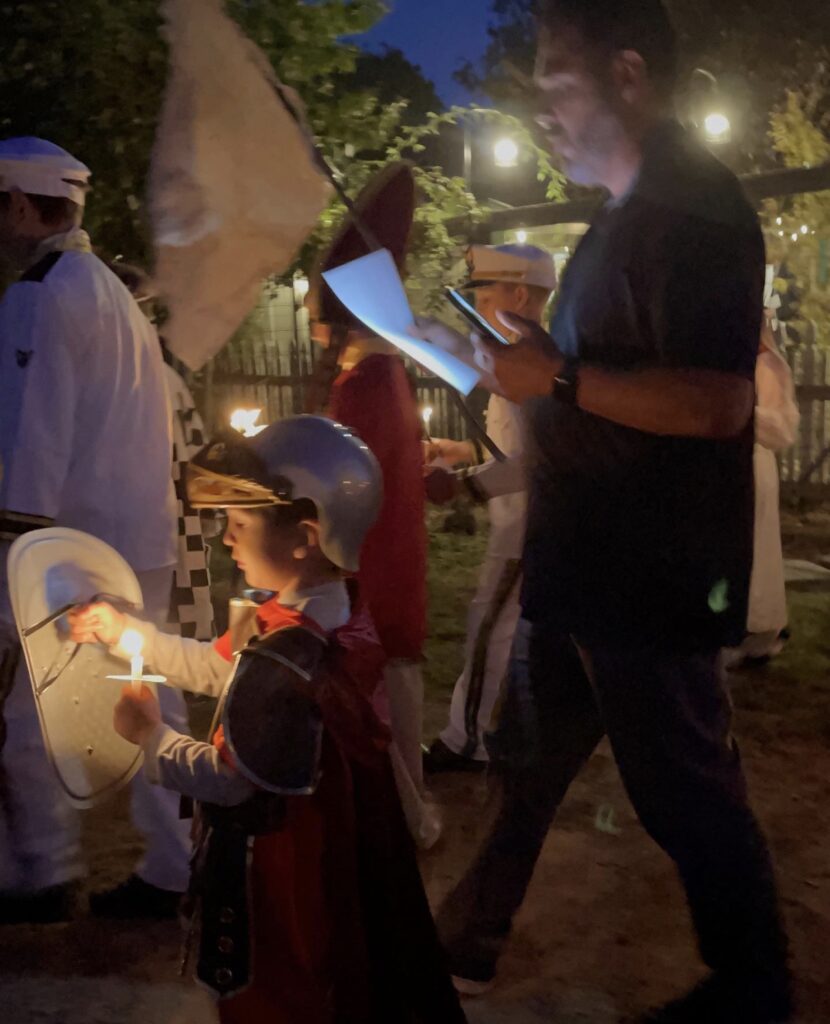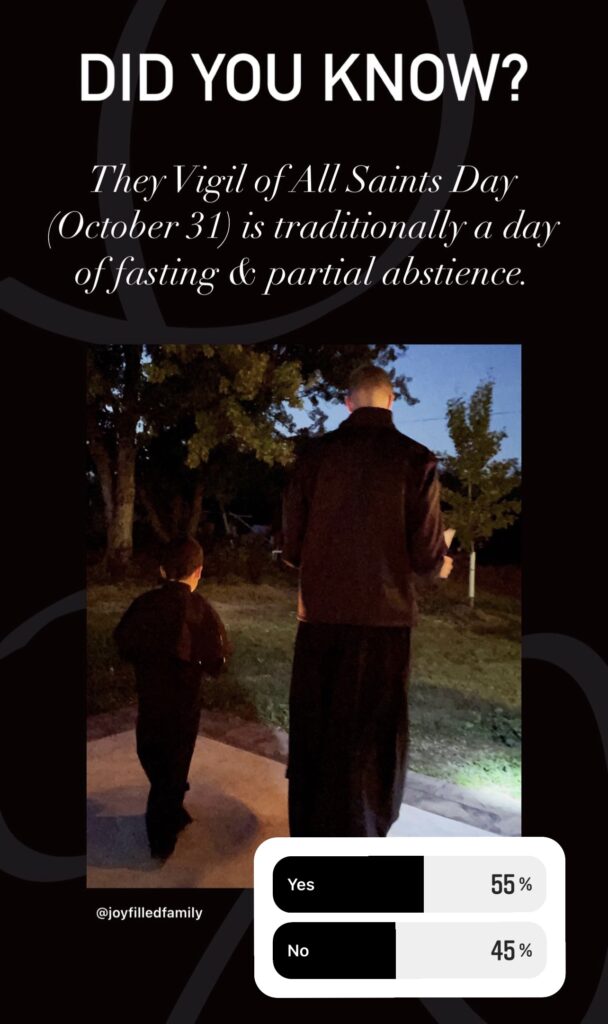October 31st is the Vigil of All Saints Day. Traditionally, it is a day of fasting and partial abstinence.

➕
In the first ages, during the night before every feast, a vigil was kept. In the evening the faithful assembled in the place or church where the feast was to be celebrated and prepared themselves by prayers, readings from Holy Writ (now the Offices of Vespers and Matins), and sometimes also by hearing a sermon. On such occasions, as on fast days in general, Mass also was celebrated in the evening, before the Vespers of the following day. Towards morning the people dispersed to the streets and houses near the church, to wait for the solemn services of the forenoon. This vigil was a regular institution of Christian life and was defended and highly recommended by St. Augustine and St. Jerome. – The Catholic Encyclopedia 1909
➕
Collect of the Vigil All Saints
O Lord, our God, multiply Thy graces upon us, and grant that joy may follow in the holy praise of those whose glorious festival we anticipate. Through our Lord Jesus Christ Thy Son, Who liveth and reigneth with Thee, in the unity of the Holy Ghost, one God, world without end. Amen.
➕
Canticum Magnificat (from Vespers on the Vigil of All Saints)
{Antiphon from the Proper of Saints}
Ant. O ye Angels, * ye Archangels, ye Thrones and Dominions, ye Principalities and Powers, ye mighty ones of the heavens, ye Cherubim and Seraphim, O ye Patriarchs and Prophets, ye holy Teachers of the Law, O ye Apostles, O all ye Martyrs of Christ, ye holy Confessors, ye Virgins of the Lord, ye Hermits, O all ye holy children of God, make intercession for us.

Let us prepare our souls for the graces heaven is about to shower upon the earth in return for its homage.
Tomorrow the Church will be so overflowing with joy, that she will seem to be already in possession of eternal happiness; but today she appears in the garb of penance, confessing that she is still an exile.
Let us fast and pray with her; for are not we too pilgrims and strangers in this world, where all things are fleeting and hurry on to death?
Year by year, as the great solemnity comes round, it has gathered from among our former companions new saints, who bless our tears and smile upon our songs of hope.
Year by year the appointed time draws nearer, when we ourselves, seated at the heavenly banquet, shall receive the homage of those who succeed us, and hold out a helping hand to draw them after us to the home of everlasting happiness.
Let us learn, from this very hour, to emancipate our souls; let us keep our hearts free, in the midst of the vain solicitudes and false pleasures of a strange land: the exile has no care but his banishment, no joy but that which gives him a foretaste of his fatherland.
With these thoughts in mind, let us say with the Church the Collect of the vigil.
➕
Domine Deus noster, multiplica super nos gratiam tuam: et, quorum prævenimus gloriosa solemnia, tribue subsequi in sancta professione lætitiam. Per Dominum.
O Lord our God, multiply thy grace upon us; and grant us in our holy profession to follow the joy of those, whose glorious solemnity we anticipate. Through our Lord.
domprospergueranger #theliturgicalyear #vigilofallsaints

The councils of Spain and Gaul, as early as the sixth century, (Concil. Gerund, an. 517, can. 3; Lugdun. II. an. 567, can. 1.) mention a custom then existing, of sanctifying the commencement of November by three days of penance and litanies, like the Rogation days which precede the feast of our Lord’s Ascension.
The fast on the Vigil of All Saints is the only remaining vestige of this custom of our forefathers, who, after the institution of the feast, advanced the triduum of penance, so as to make it a preparation for the solemnity itself. “Let our devotion be complete,” is the recommendation of a contemporaneous author; “let us prepare ourselves for this most holy solemnity by three days of fasting, prayer and almsdeeds.” (Inter Opera ALUINI, Epist. xci. ad calcem.)
When extended to the entire world, the feast became complete; it was made equal to the greatest solemnities, and widened its horizon till it reached the infinite, embracing uncreated as well as created sanctity. Its object was now, not only Mary and the martyrs; not only all the just children of Adam, but moreover the nine choirs of Angels, and above all the Holy Trinity Itself, God who is all in all, the King of kings, that is, of the Saints, the God of gods in Sion. Hear now the Church awakes her children on this day: Come let us adore the Lord, the King of kings, for he is the crown of all the Saints.” (Invitatory of the Feast.) Such was the invitation addressed by our Lord himself to St. Mechtilde, the chantress of Helfta, the privileged one of his divine Heart: “Praise me, for that I am the crown of all the Saints.” The virgin then beheld all the beauty of the elect and their glory drawing increase from the Blood of Christ, and resplendent with the virtues practiced by him; and responding to our Lord’s appeal, she praised with all her might the blissful and ever adorable Trinity, for deigning to be to the Saints their diadem and their admirable dignity. (Liber specialis gratiae, P . I. cap . xxxi.) – Dom Prosper Gueranger

Leave a Reply